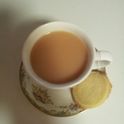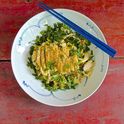I'm determined to make a peach pie, but I'm petrified of pie crusts and this will only be my second one ever. Best tips, please? Many thanks.
23 Comments
canoetripAugust 27, 2015
I used to be frightened of pastry making myself, until I tried Chezpim's "The One Pie Dough To Rule Them All". It works for me every single time. It's easy, fast, and is super fun as well! http://chezpim.com/bake/how-to-make-the-perfect-pie-dough
Give it a go! Don't be scared! :)
Give it a go! Don't be scared! :)
MakenaAugust 22, 2015
I adore this community! Thank you all so much for the guidance and support. I ended up with the ATK all butter crust (rather than the vodka one) and their peach pie recipe. Four hours later (does it always take that long??), I've got a finished pie that isn't as beautiful as theirs but I bet it'll taste terrific! I'm no longer afraid to make a pie crust from scratch. Thanks again everyone.
PieceOfLayerCakeAugust 23, 2015
Baking takes time....I think that, and its precision, is why a lot of people avoid it. But the payoff is well worth it all, as evident by that delectable looking pie! You achieved good color, and its very clear that there's A LOT of butter in that crust. <3 Very well done.
Susan W.August 23, 2015
I think your pie looks fabulous and you should be very proud. Keep making them and it will become second nature.
PieceOfLayerCakeAugust 22, 2015
While I respect everyone's opinion....there is NOTHING...absolutely nothing, like a homemade, all-butter, perfectly flaky pie crust. I'd sooner scrape out the filling and eat only the crust of a pie.
Eileen H.August 22, 2015
I'm a pretty good baker and totally look down on shortcuts and semi-homemade tricks. Having said that, I've given several different pie crust recipes a try and have finally settled on the conclusion that store-bought pie crust (the ones in the refrigerated section that you unroll) is the way to go. Every pie I make gets killer reviews; my dad, a hard-to-please former chef, even tells his friends about my pies. The Pillsbury one is probably easiest to find, but in truth I'll buy the store brand ones (Giant, Target, whatever) and really don't notice a difference. Seriously- save yourself the labor and the mess- the time you save on the pie crust can be used to create an amazing topping or garnish instead and I promise no one will ever suspect you cheated!
Stephanie G.August 22, 2015
The best advice is practice it a lot. Neighbors love pie! What has improved my pie crust considerably is the addition of lard into the fat. If you can get some quality lard, I would recommend that you sub it in for a portion of the butter. The lard elevates the average pie maker's crust. What you don't have yet in skill can be helped by lard! I do think the European butters make better crusts too.
drbabsAugust 22, 2015
Also, it's pie! So try not to be terrified. what's the worst thing that will happen? You're baking at home and you're making people dessert. If you're bringing it to someone's house, buy some great ice cream to go with it. I promise everyone will love you.
Sam1148August 22, 2015
use much less water (or the chilled vodka water mix) than you think.
The dough should 'just' come together. Then rest it in the fridge...then roll it out and rest it again in the freezer in the pie plate. Then dock it...and 'blind bake it'...cool it fill it.
And honestly. Have you get the feel of making a crust the vodka isn't needed.
that's there to keep you from overworking the dough and making a tough crust.
It's great and if you haven't done crusts before use it. But eventually it isn't needed.
Using a food processor is a good step too. Processes the fat/butter in batches.
And resist the urge to dump in the liquid. It should be a 'clumpy' dough instead of a ball. You use your hands to make the ball and rest it...it..etc.
The dough should 'just' come together. Then rest it in the fridge...then roll it out and rest it again in the freezer in the pie plate. Then dock it...and 'blind bake it'...cool it fill it.
And honestly. Have you get the feel of making a crust the vodka isn't needed.
that's there to keep you from overworking the dough and making a tough crust.
It's great and if you haven't done crusts before use it. But eventually it isn't needed.
Using a food processor is a good step too. Processes the fat/butter in batches.
And resist the urge to dump in the liquid. It should be a 'clumpy' dough instead of a ball. You use your hands to make the ball and rest it...it..etc.
boulangereAugust 22, 2015
I hope this tutorial will help grow your confidence:
https://thesolitarycook.wordpress.com/2012/07/28/perfect-flaky-pastry/
There is nothing better than a peach pie in summer.
https://thesolitarycook.wordpress.com/2012/07/28/perfect-flaky-pastry/
There is nothing better than a peach pie in summer.
PieceOfLayerCakeAugust 22, 2015
Practice. Look at this as practice. Don't be afraid and just go for it. I've made a lot of questionable pie crusts but I eventually got a feel for it. Just keep everything cold. When I first began my quest for good pie crust I chilled everything: my flour, sugar, butter, salt and I put ice in my water. I also recommend you make it by hand, if not working the butter in by hand, at least mix the liquid in by hand. It'll give you a feel for it, its not difficult and less dishes. If at any point during the process you get frustrated or hesitant, wrap it up, put it in the fridge and let it rest. Be patient with it and yourself.
SmaugAugust 22, 2015
By all means do it by hand- it's really the only way to get a feel for what's going on, it makes a better crust, and it's really no more time and trouble than pulling out the food processor, washing it etc. And remember- a well made crust will be a bit of a pain to roll out, it doesn't mean you've done anything wrong.
SmaugAugust 21, 2015
Also, Rose Levy Beranbaum has a crust recipe that, while tending to the bizarre (it's assembled in a plastic bag, for one thing), does work very well and rolls beautifully. I find it too soft for my tastes, but that's the effect she's after, and gets.
SmaugAugust 21, 2015
You might try the Vodka pie crust advocated by the America's Test Kitchen gang- it really does work quite well, and is easier to handle than a standard crust. For peach, you might consider subbing dark rum or whiskey for the vodka- it adds a nice touch.
sonyaAugust 22, 2015
Here it is; I love it!
For one 9-inch Single-Crust Pie
Vodka is essential to the texture of the crust and imparts no flavor—do not substitute extra water. The alcohol is key to our recipe; if you don't have vodka on hand, you can use another 80 proof liquor. This dough will be moister and more supple than most standard pie doughs and will require more flour to roll out (up to 1/4 cup).
Ingredients
1 1/4 cups unbleached all-purpose flour (6 1/4 ounces)
1/2 teaspoon table salt
1 tablespoon sugar
6 tablespoons cold unsalted butter (3/4 stick), cut into 1/4-inch slices
1/4 cup chilled solid vegetable shortening, cut into 2 pieces
2 tablespoons vodka, cold
2 tablespoons cold water
Instructions
1. Process 3/4 cups flour, salt, and sugar together in food processor until combined, about 2 one-second pulses. Add butter and shortening and process until homogenous dough just starts to collect in uneven clumps, about 10 seconds (dough will resemble cottage cheese curds with some very small pieces of butter remaining, but there should be no uncoated flour). Scrape down sides and bottom of bowl with rubber spatula and redistribute dough evenly around processor blade. Add remaining 1/2 cup flour and pulse until mixture is evenly distributed around bowl and mass of dough has been broken up, 4 to 6 quick pulses. Empty mixture into medium bowl.
2. Sprinkle vodka and water over mixture. With rubber spatula, use folding motion to mix, pressing down on dough until dough is slightly tacky and sticks together. Flatten dough into 4-inch disk. Wrap in plastic wrap and refrigerate at least 45 minutes or up to 2 days.
3. Adjust oven rack to lowest position, place rimmed baking sheet on oven rack, and heat oven to 425 degrees. Remove dough from refrigerator and roll out on generously floured (up to ¼ cup) work surface to 12-inch circle about 1/8 inch thick. Roll dough loosely around rolling pin and unroll into pie plate, leaving at least 1-inch overhang on each side. Working around circumference, ease dough into plate by gently lifting edge of dough with one hand while pressing into plate bottom with other hand. Leave overhanging dough in place; refrigerate until dough is firm, about 30 minutes.
4. Trim overhang to ½ inch beyond lip of pie plate. Fold overhang under itself; folded edge should be flush with edge of pie plate. Flute dough or press the tines of a fork against dough to flatten it against rim of pie plate. Refrigerate dough-lined plate until firm, about 15 minutes.
5. Remove pie pan from refrigerator, line crust with foil, and fill with pie weights or pennies. Bake for 15 minutes. Remove foil and weights, rotate plate, and bake for 5 to 10 minutes additional minutes until crust is golden brown and crisp.
Step-by-Step
Key Steps to Foolproof Pie Dough
1. MAKE A FAT AND FLOUR PASTE: Completely blending part of the flour with all of the butter ensures a consistent amount of fat-coated flour in the final dough.
2. ADD MORE FLOUR: Pulsing in the final cup of flour ensures a consistent amount of uncoated flour in the final dough.
3. ADD WATER AND VODKA: Sprinkling with water and vodka ensures even distribution. No need to skimp—unlike water, vodka won't make the dough tough."
Source: http://www.cooksillustrated...
For one 9-inch Single-Crust Pie
Vodka is essential to the texture of the crust and imparts no flavor—do not substitute extra water. The alcohol is key to our recipe; if you don't have vodka on hand, you can use another 80 proof liquor. This dough will be moister and more supple than most standard pie doughs and will require more flour to roll out (up to 1/4 cup).
Ingredients
1 1/4 cups unbleached all-purpose flour (6 1/4 ounces)
1/2 teaspoon table salt
1 tablespoon sugar
6 tablespoons cold unsalted butter (3/4 stick), cut into 1/4-inch slices
1/4 cup chilled solid vegetable shortening, cut into 2 pieces
2 tablespoons vodka, cold
2 tablespoons cold water
Instructions
1. Process 3/4 cups flour, salt, and sugar together in food processor until combined, about 2 one-second pulses. Add butter and shortening and process until homogenous dough just starts to collect in uneven clumps, about 10 seconds (dough will resemble cottage cheese curds with some very small pieces of butter remaining, but there should be no uncoated flour). Scrape down sides and bottom of bowl with rubber spatula and redistribute dough evenly around processor blade. Add remaining 1/2 cup flour and pulse until mixture is evenly distributed around bowl and mass of dough has been broken up, 4 to 6 quick pulses. Empty mixture into medium bowl.
2. Sprinkle vodka and water over mixture. With rubber spatula, use folding motion to mix, pressing down on dough until dough is slightly tacky and sticks together. Flatten dough into 4-inch disk. Wrap in plastic wrap and refrigerate at least 45 minutes or up to 2 days.
3. Adjust oven rack to lowest position, place rimmed baking sheet on oven rack, and heat oven to 425 degrees. Remove dough from refrigerator and roll out on generously floured (up to ¼ cup) work surface to 12-inch circle about 1/8 inch thick. Roll dough loosely around rolling pin and unroll into pie plate, leaving at least 1-inch overhang on each side. Working around circumference, ease dough into plate by gently lifting edge of dough with one hand while pressing into plate bottom with other hand. Leave overhanging dough in place; refrigerate until dough is firm, about 30 minutes.
4. Trim overhang to ½ inch beyond lip of pie plate. Fold overhang under itself; folded edge should be flush with edge of pie plate. Flute dough or press the tines of a fork against dough to flatten it against rim of pie plate. Refrigerate dough-lined plate until firm, about 15 minutes.
5. Remove pie pan from refrigerator, line crust with foil, and fill with pie weights or pennies. Bake for 15 minutes. Remove foil and weights, rotate plate, and bake for 5 to 10 minutes additional minutes until crust is golden brown and crisp.
Step-by-Step
Key Steps to Foolproof Pie Dough
1. MAKE A FAT AND FLOUR PASTE: Completely blending part of the flour with all of the butter ensures a consistent amount of fat-coated flour in the final dough.
2. ADD MORE FLOUR: Pulsing in the final cup of flour ensures a consistent amount of uncoated flour in the final dough.
3. ADD WATER AND VODKA: Sprinkling with water and vodka ensures even distribution. No need to skimp—unlike water, vodka won't make the dough tough."
Source: http://www.cooksillustrated...
MonitaAugust 21, 2015
I've found that the key to a good crust is 1)cold butter and 2)not over-working the dough. My "go-to" recipe is from Martha Stewart Living and I use it for every pie I make.
http://www.marthastewart...
http://www.marthastewart...
Showing 21 out of 23 Comments
Recommended by Food52
Popular on Food52
Continue After Advertisement






